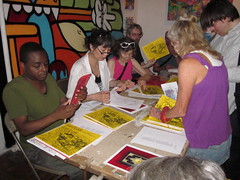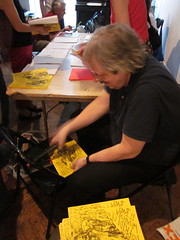Nearly two dozen people walked past the “For Sale” sign and closed gate of a townhouse on Third Street on Sunday, invited themselves in the unlocked door, and made their way up to the second floor with folders of their work in tow.
When they walked in, it was like a mini reunion of yesteryear’s East Village art world: everyone knew each other, liked each other’s work, and swapped stories about peers of old.
And then they got to work publishing a magazine.
They were all there to put together the 34th issue of “What Happens Next,” an assembly magazine made up of poems, collages and drawings. The event, and the 33 issues prior, have been organized by Eve Packer who started it “just to have a forum” for the work of she and her friends, and anyone else who wanted to jump in.
The magazine is made up of individual work provided by the participants, with each bringing 100 copies of their pieces. The assembly aspect of the magazine is very literal: everyone lines their stack up and they start passing it along, with one person at the end taking charge with a stapler.
“It looks like a sweatshop, but we sell poetry,” said Tom Weiss, who attended the meeting.
Sell isn’t quite the right word, though. The point, participants say, is to come together and enjoy each others art. In the end, everyone walks away with at least one complete copy and maybe a couple extra to pass along to friends. No one has any (visible) illusions of grandeur or riches coming out of the project.
“It’s not about selling them, it’s just about distributing it to as many people as you can,” said Steve Dalachinsky, 64, who contributed a collage to the issue. “It’s the one thing to kind of give back to the community. The community is an illusion so it’s a matter of keeping the illusion of the community alive.”
One participant, Ron Kolm, 64, is essentially a self-appointed chronicler of the East Village literary scene, having lived in the area decades ago while producing art and befriending artists. Mr. Kolm always carries a bag full of “artifacts” as he calls them, including palm-sized poetry pieces or self-published books, handing them out to friends — something he has done for years with ‘What Happens Next.’
“There are the archives at NYU and SUNY that will take copies, or we could just go to bookstores — like St. Mark’s Bookshop’ll take it. Or sometimes I just go to public libraries with plastic bags filled with artifacts and give it to them,” Mr. Kolm said.
“When you put things in archives, realistically, no one’s ever going to see them anyway, let’s be honest. But there’s always the chance that someone will.”
You’d think that in a neighborhood that celebrates its old world ways and glorifies the image of the East Village of yore, something like this would be a hot ticket item. Instead, it was attended by the die-hards, all of whom had work included in the issue and many of whom had been involved for upward of a decade.
Held at the Gathering of Tribes, the meeting of artistic minds and fast hands had a very familial feel. Steve Cannon, 75, runs Gathering of Tribes as an art space that often hosts poetry readings, parlor discussions and the works of new artists. Though the future of the space is currently up in the air, with the current owner asking for $3 million for the building, Gathering of Tribes has had more of an impression on some visitors than any old meeting place.
“He created a climate of creativity and encouragement,” Rob Hardin, 44, said of Mr. Cannon; Mr. Hardin contributed a work of prose to the most recent issue.
Ms. Packer started the project in 1987 as a venue for people to share their work without having to navigate the freelance process and other issues inherent to mainstream publications.
“I thought ‘we should have a reading and we should have a ‘zine, so why don’t we start one?’ My thing is that you should always make your own thing and don’t depend on other people to include you in theirs,” Ms. Packer said.
While the group has been more prolific in some years than others, it has produced at least one issue a year since its inception.
The goal, Ms. Packer said, is “to keep it going and to keep the community going.”






